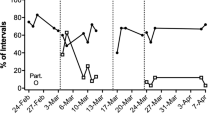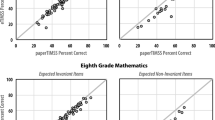Abstract
Fidget spinners have become popular worldwide, due not only to their popularity with children but also to the mental health claims made by those who advertise them. While a small number of previous research studies indicate that fidget spinners reduce on-task behavior, no research to date has evaluated their effect on student performance. The current study evaluated 3rd grade students to determine whether their performance on 5-min math curriculum–based measures (CBM) changed depending on whether they had access to a fidget spinner. Results indicated that student performance was lower when they were allowed to use fidget spinners than when the fidget spinner was removed. The current study suggests that fidget spinners may cause a deficit in student performance. However, the effect of fidget spinners may actually lessen as the students habituate to the objects.

Similar content being viewed by others
References
Anderson, D., Rowley, Alonzo, J., & Tindal, G. (2010). easyCBM Mathematics Criterion Related Validity Evidence: Oregon State Test (Technical Report No. 1011). Eugene: Behavioral Research and Teaching, University of Oregon.
Anderson, D., Alonzo, J., Tindal, G., Farley, D., Irving, P. S., Lai, C., & Wrat, K. A. (2013). Technical manual: easyCBM. (Technical Report No. 1408). Eugene: Behavioral Research and Teaching, University of Oregon.
Ayres, A. J. (1972). Improving academic scores through sensory integration. Journal of Learning Disabilities, 5(6), 338–343.
Baumgartner, S. E., & Sumter, S. R. (2017). Dealing with media distractions: An observational study of computer-based multitasking among children and adults in the Netherlands. Journal of Children and Media, 11(3), 295–313.
Biel, L. (2017). Fidget toys or focus tools? The Autism File 74, 12–13. https://www.sensorysmarts.com/AADJun17.pdf.. Accessed 17 May 2017.
Briesch, A. M., & Chafouleas, S. M. (2009a). Children’s Usage Rating Profile (Actual). Storrs, CT: University of Connecticut.
Briesch, A. M., & Chafouleas, S. M. (2009b). Exploring student buy-in: Initial development of an instrument to measure likelihood of children's intervention usage. Journal of Educational and Psychological Consultation, 19(4), 321–336.
Carson, S., Shih, M., & Langer, E. (2001). Sit still and pay attention? Journal of Adult Development, 8(3), 183–188.
Chen, P., Saleh, W., & Pai, C. (2017). Texting and walking: A controlled field study of crossing behaviours and inattentional blindness in Taiwan. Behaviour & Information Technology, 36(4), 432–445.
Economist.com (2017). The lessons of fidget spinners. Retrieved from Economist.com on September 28, 2017.
Finley, J. R., Benjamin, A. S., & McCarley, J. S. (2014). Metacognition of multitasking: How well do we predict the costs of divided attention? Journal of Experimental Psychology: Applied, 20(2), 158–165.
Fox, A. B., Rosen, J., & Crawford, M. (2009). Distractions, distractions: Does instant messaging affect college students’ performance on a concurrent reading comprehension task? Cyberpsychology & Behavior, 12(1), 51–53.
Graziano, P. A., Garcia, A. M., & Landis, T. D. (2018). To fidget or not to fidget, that is the question: A systematic classroom evaluation of fidget spinners among young children with ADHD. Journal of Attention Disorders, 24, 163–171. https://doi.org/10.1177/1087054718770009.
Greene, C. M., Murphy, G., & Januszewski, J. (2017). Under perceptual load, observers look but do not see. Applied Cognitive Psychology, 31(4), 431–437.
Grodner, K. (2015). To fidget or not to fidget: The effect of movement on cognition (Master’s Thesis). Retrieved from https://search.proquest.com/docview/1728335820
Harman, B. A., & Sato, T. (2011). Cell phone use and grade point average among undergraduate university students. College Student Journal, 45(3), 544–550.
Hattie, J. (2015). Hattie ranking: 195 influences and effect sizes related to student achievement. Hentet, 19, 2018.
Junco, R. (2012). In-class multitasking and academic performance. Computers in Human Behavior, 28(6), 2236–2243.
Junco, R., & Cotten, S. R. (2012). No A 4 U: The relationship between multitasking and academic performance. Computers & Education, 59(2), 505–514.
Lepp, A., Barkley, J. E., & Karpinski, A. C. (2015). The relationship between cell phone use and academic performance in a sample of US college students. SAGE Open, 5(1), 215824401557316.
Levine, J. A., Schleusner, S. J., & Jensen, M. D. (2000). Energy expenditure of nonexercise activity. The American Journal of Clinical Nutrition, 72(6), 1451–1454. https://doi.org/10.1093/ajcn/72.6.1451
Memmert, D. (2014). Inattentional blindness to unexpected events in 8–15-year-olds. Cognitive Development, 32, 103–109.
Nyqvist, R. (2016). Fidgeting for creativity. Unpublished master’s thesis. Lund: Lund University Retrieved from http://lup.lub.lu.se/student-papers/record/8888395. Accessed 17 May 2017.
Pappas, S. (2017). Fidget spinners: What they are, how they work and why the controversy. Livestock Science Downloaded from Livescience.com on September 28, 2017.
Pashler, H. (1994). Dual-task interference in simple tasks: Data and theory. Psychological Bulletin, 116(2), 220–244.
Reschly, A. L., & Christenson, S. L. (2012). Jingle, jangle, and conceptual haziness: Evolution and future directions of the engagement construct. In Handbook of research on student engagement (pp. 3–19). Boston, MA: Springer.
Saven, J. L., Irvin, P. S., Park, B. J., Alonzo, J., & Tindal, G. (2013). The Development and Scaling of the easyCBM CCSS Elementary Mathematics Measures: Grade 3 (Technical Report No. 1317). Eugene: Behavioral Research and Teaching, University of Oregon.
Schaaf, R. C., & Miller, L. J. (2005). Occupational therapy using a sensory integrative approach for children with developmental disabilities. Developmental Disabilities Research Reviews, 11(2), 143–148.
Schecter, R. A., Shah, J., Fruitman, K., & Milanaik, R. L. (2017). Fidgets spinners: Purported benefits, adverse effects, and accepted alternatives. Current Opinion in Pediatrics, 29(5), 616–618.
Simons, D. J., & Chabris, C. F. (1999). Gorillas in our midst: Sustained inattentional blindness for dynamic events. Perception, 28(9), 1059–1074.
Skinner, E., Furrer, C., Marchand, G., & Kindermann, T. (2008). Engagement and disaffection in the classroom: Part of a larger motivational dynamic? Journal of Educational Psychology, 100(4), 765–781.
Slater, D., & French, J. (2010). Fidget toys in the classroom: Refocusing attention. SoTL Commons Conference Retrieved from https://digitalcommons.georgiasouthern.edu/sotlcommons/SoTL/2010/4. Accessed 17 May 2017.
Stalvey, S., & Brasell, H. (2006). Using stress balls to focus the attention of sixth-grade learners. Journal of At-Risk Issues, 12(2), 7–16.
Strayer, D. L., Watson, J. M., & Drews, F. A. (2011). Cognitive distraction while multitasking in the automobile. Psychology of Learning and Motivation, 54, 29–58 Academic Press.
Tornio, S. (2017). 15 fidget toys & devices to will make any classroom calmer & happier. We Are Teachers Retrieved from https://www.weareteachers.com/fidget-toys/. Accessed 17 May 2017.
Woolner, P., Hall, E., Higgins, S., McCaughey, C., & Wall, K. (2007). A sound foundation? What we know about the impact of environments on learning and the implications for building schools for the future. Oxford Review of Education, 33(1), 47–70.
Wray, K. A., Alonzo, J., & Tindal, G. (2014). Internal Consistency of the easyCBM CCSS Math Measures Grades K-8 (Technical Report No. 1405). Eugene: Behavioral Research and Teaching, University of Oregon.
Yang, T., Xie, W., Chen, C., Altgassen, M., Wang, Y., Cheung, E. F. C., & Chan, R. C. K. (2017). The development of multitasking in children aged 7-12 years: Evidence from cross-sectional and longitudinal data. Journal of Experimental Child Psychology, 161, 63–80.
Author information
Authors and Affiliations
Corresponding author
Ethics declarations
Conflict of Interest
The authors declare that they have no conflict of interest.
Ethical Approval and Informed Consent
All ethical procedures including the collection of informed consent performed in this study were in accordance with the ethical standards of the Institutional Research Boards of the two institutions.
Additional information
Publisher’s Note
Springer Nature remains neutral with regard to jurisdictional claims in published maps and institutional affiliations.
Rights and permissions
About this article
Cite this article
Hulac, D.M., Aspiranti, K., Kriescher, S. et al. A Multisite Study of the Effect of Fidget Spinners on Academic Performance. Contemp School Psychol 25, 582–588 (2021). https://doi.org/10.1007/s40688-020-00292-y
Published:
Issue Date:
DOI: https://doi.org/10.1007/s40688-020-00292-y




